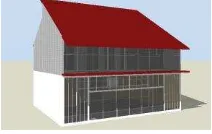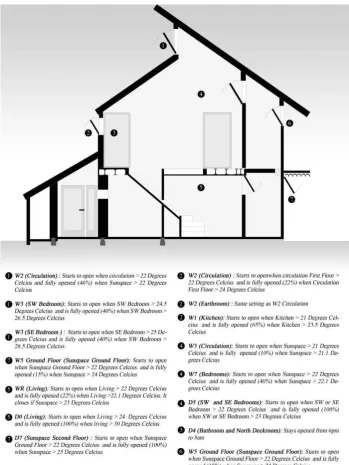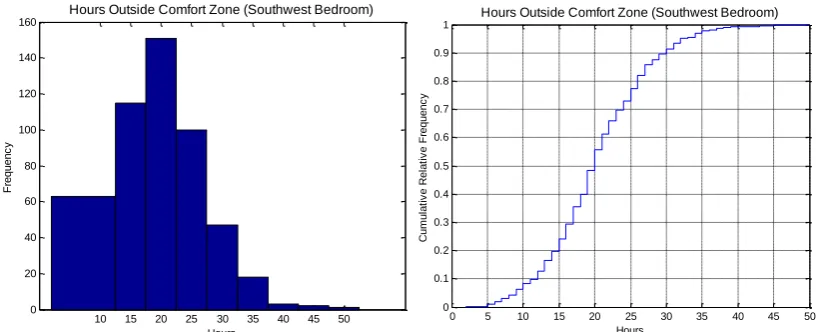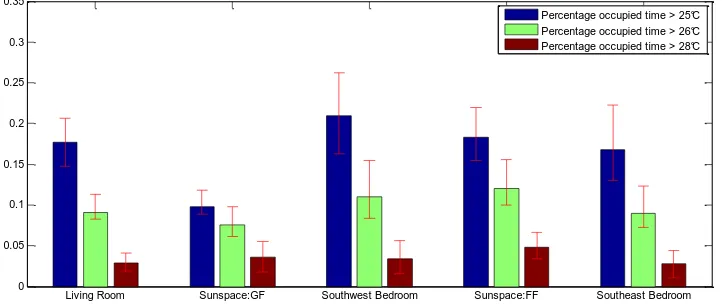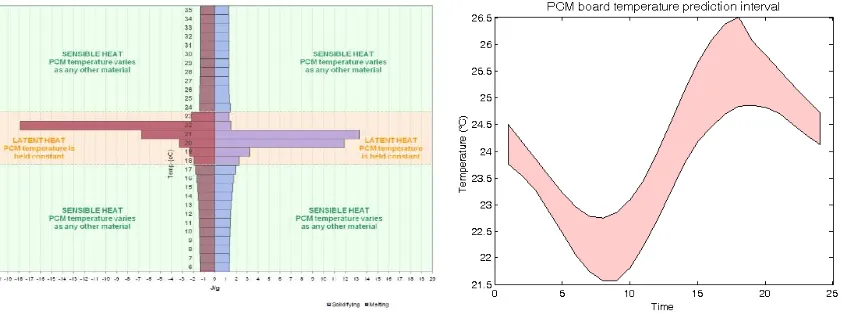Re-evaluation of Passive Design Measures
in the BASF House in Recognition of
Uncertainty and Model Discrepancy
Qinpeng Wang, PhD candidate Yuna Zhang, PhD candidate Sandeep Ahuja, MS HPB
[Georgia Institute of Technology] [Georgia Institute of Technology] [Georgia Institute of Technology] [email protected]
Godfried Augenbroe, Professor
[Georgia Institute of Technology]
ABSTRACT
Located in Nottingham, the BASF house serves as an example for energy efficiency and affordability. The house incorporates a number of passive and active measures to allow thermal comfort for residents. The success of these passive strategies appears to be supported by energy simulation studies. However, before establishing confidence in the results attained by energy simulations, it is critical to understand that energy modelers rely on simulation software to predict building energy performance. Despite the maturity of current energy simulation tools, they are inadequate to make precise predictions for the obvious reasons that local conditions, physical parameters, and usage scenarios are not fully known. As a consequence, passive design measures may fail to achieve their expected benefits. Indeed, models may show predictions that deviate from what we would observe in the realized building. The primary cause of such deviation is uncertainties in the model parameters and formulations. The important question to be raised is whether the recognition of the performance gap between design and reality would lead us to rethink the applicability of passive design measures. This paper focuses on analyzing the impact of those uncertainties on the evaluation of passive design measures in the BASF house. The exploration focuses on the risk that a passive design solution may cause unacceptable discomfort, which could potentially lead to its rejection despite its initial selection based on the results of a conventional energy simulation. This level of understanding is essential if we are to make rational design decisions regarding the applicability of passive strategies.
INTRODUCTION
In 2007, BASF, a German chemical company devoted to energy efficiency and resource protection, initiated a project to design, construct, and test modern methods of construction in six innovative, flexible houses. The first to be completed was the BASF house, located in Nottingham, England. Built in wet, cold weather, the house contains both active and passive strategies, the latter of which play a crucial role in establishing thermal comfort of residents.
Passive Strategies
designers need to thoroughly investigate the thermal characteristics of building components and systems to determine the optimal solution to minimizing heat loss in the winter and heat gain in the summer.
Although a purely “passive” design without any mechanical intervention is preferable in terms of
energy, more often than not, it does not meet the thermal comfort requirements, leading to the creation of hybrid systems, that is, incorporating mechanical devices into passive elements allowing the latter to function appropriately. One example is the BASF house, which combines a range of strategies such as shading, buffer zones, compactness, highly insulated building fabric, and double-glazed windows, as well as phase-change materials on the ceiling, an earth-air heat exchanger for cooling and pre-heating air, and natural ventilation in order to achieve desired performance.
Earth-Air Heat Exchanger
Earth air heat exchangers, buried to moderate depths, are generally underground horizontal ducts or pipes in which outside fresh air or re-circulated air is conditioned by the thermal mass of the earth and channeled into the house. To enhance heat transfer, pipes are usually made of polypropylene.
Phase-Change Materials
Because of their high storage density and latent heat property, phase-change materials are critical in the thermal energy storage of the building envelope system. One of the potential applications for phase-change materials is to incorporate them into the envelope system in buildings for energy conservation. During the summer, benefits include a time shift in the thermal load during the day and thus a decrease in the peak temperature. Since they will help reduce cooling loads by absorbing heat during the day and recycling it during the night, it is hypothesized that phase-change materials will work efficiently in the climate of Nottingham with warm days and cold nights.
A METHODOLOGY FOR EVALUATIING PASSIVE MEASURES UNDER UNCERTAINTY
To evaluate the performance of passive strategies, designers base their decisions on energy simulation results to predict building behavior after implementation. However, when predicting the performance of buildings, current building performance assessment tools do not account for risks that
can lead to designers’ having false confidence about the expected performance of sustainable measures
and an impression about the likely underperformance of passive houses in reality. Mlakar and Strancar (2011), and Rodrigues and Gillott (2011) showed problems of overheating in passive houses during operation in the summer with in-situ measurements. Furthermore, Larsen and Jensen (2011) acknowledged that possible problems with high indoor temperatures are not anticipated during the design process via simulations but observed after the building is finished at the site. These findings motivate us in proposing a methodology for evaluating passive design measures with a clear indication of the risks of indoor discomfort. Additional risk information will infuse confidence about the
effectiveness of proposed design measures for improving the thermal comfort of a passive house.
quantifies the impact of physical parameter uncertainties, modeler assumptions, and model simplifications on the outcomes. Such an analysis is typically carried out using a Monte Carlo approach with an appropriate sampling technique in order to increase computational efficiency. The Monte Carlo (MC) simulation uses random number generators to model stochastic event occurrences.
de Wit and Augenbroe (2002) and MacDonald (2002) introduced a general procedure for uncertainty analysis of building thermal performance. Khazaii (2012) studied different sources of HVAC system uncertainty such as equipment manufacture tolerance, system degradation, and duct leakage. Wang, Augenbroe and Sun (2014) quantified the impact of realization uncertainty of construction detailing and workmanship on building energy performance. Their studies showed that a quantitative uncertainty assessment is essential in a design decision making process. These efforts represent only a small slice of a growing body of work that studies the effect of uncertainties encountered at various model levels (e.g., micro-climate, building level, and system level). Referring to the above sources, this paper uses the parameter uncertainty quantifications and techniques.
This paper casts new light on the evaluation of passive design strategies, which will explicitly show risks associated with design decisions. It will provide designers with quantitative evidence that certain levels of building performance will be accomplished or not. In this study, we propagate uncertainties through GURA-W (Georgia Tech Uncertainty and Risk Analysis Workbench) (Lee, Sun, Augenbroe and Paredis 2013). The probability distributions of uncertainty parameters are contained in an XML repository and sampled with Latin hypercube sampling. We then feed these uncertainty parameters into an EnergyPlus simulation engine. Eventually, the simulation results will show the performance of passive design strategies and their associated risks. The following sections present a case study showcasing the validity and value of our proposed methodology.
BASF HOUSE AND MODEL ASSUMPTIONS
The BASF house has an area of about 100 m2 divided into ground and first floors as depicted in
Figure 1. The ground floor mainly consists of an open-plan living room and a kitchen with a staircase connected to the first floor, allowing natural ventilation from the stack effect. The first floor comprises of two main southern bedrooms and a smaller one on the north (unoccupied). The house has a fully glazed double-height southern sunspace with external shading and internal adjustable blinds. Openings are carefully placed around the house, facilitating optimal use of natural cooling in the summer.
Figure 1. the BASF house
In terms of construction methods, ground floor walls are made of insulated concrete formwork (ICF) while the first floor walls and the roof are constructed of structural insulated panels (SIPs). In total, 100 m2 of PCM boards that store and release heat from the living room, bedrooms, and the
sunspace are sandwiched between plasterboards and oriented strand boards (OSB). Windows and curtain walls are double glazed and filled with argon with a U-value of 1.66W/m2K. The interface between
multiple construction methods eliminates easily avoidable thermal bridges. In addition, the air permeability of the house is addressed by incremental pressurization tests and vulnerable area treatment,
so the final house is among the most airtight in the United Kingdom (3.38m3/h/m2 at 50 Pa). An earth air
heat exchanger containing 36m of piping buried at a depth of 1.5m supplies 0.05 m3/s of precooled or
Figure 2. Ventilation strategy in the BASF house
The development of thermal models requires a series of further assumptions. Information on construction types, occupancy schedules, and internal heat gains are loyal to the design intention and onsite implementation. PCM boards are simulated using the conduction finite difference solution algorithm in EnergyPlus, which uses an implicit finite difference scheme coupled with an enthalpy-temperature function to account for phase-change energy accurately. The local soil type is assumed to be standard (density 1800kg/m3, conductivity 1.45W/mK, and thermal diffusivity 6.015×10-7m2/s) in the
calculation of the average temperature, the amplitude and the phase constant of the soil surface. Then the performance of the earth-air heat exchanger is determined given these boundary conditions. Figure 2 showcases the ventilation strategy. More information about the BASF house can be found in Rodrigues (2010).
RE-EVALUATION OF MEASURES IN THE BASF HOUSE
specific degree of confidence, for instance expressed as a discomfort risk tolerance such as the allowed probability that the number of discomfort hours is exceeded. Rodrigues and Gillott (2011) compared deterministic simulation results with actual measurements for the BASF house and concluded that the simulation results are similar to the actual measurements except that the former over-predict the overheating issue in the sunspace and underestimate it in the north bedroom. The recorded observations seem to strengthen our argument that relying totally on deterministic results may give rise to false confidence and be insufficient in supporting design decision making. Therefore, the proposed design measures for the BASF house must be reevaluated under uncertainty. As an example, this study analyzes the risk of overheating in July, when the peak temperature might occur in Nottingham.
Risk of Overheating
According to CIBSE, the benchmark for overheating is 26°C in the living room and 25°C in the bedroom. If the benchmark is exceeded, the duration of the time above 28°C in the living room and 26°C in the bedroom should be no longer than 1%. Therefore, we first take the percentage of occupied time (12am to 9am, 5pm to 12am on weekdays; all the time on weekends) outside the above comfort zone as the performance indicator to evaluate the risk of overheating in the BASF house. Another way to rate discomfort is the absolute number of hours that a certain threshold is exceeded during a given critical month. The following results can be easily translated to the absolute number of hours in July by realizing that 1% corresponds to 5 to 6 hours. It should be noted that in order to identify if certain measures could fail the comfort tolerance of future occupants, a risk conscious measure will have to be established. If, for the sake of the argument, we assume that the risk tolerance of the occupants is that in the southwest bedroom in July, the probability that the number of discomfort hours above 28°C exceeds 35 (or 6% of the occupied time) cannot be higher than 8%, we would see that the current design would be acceptable based on Figures 3a and 3b. Figure 3a shows the distribution of the number of hours in July, when the temperature in the southwest bedroom exceeds 28°C during occupied hours. The predicted range is the combined effect of the uncertainties mentioned above. In Figure 3b, the error bar represents the 90 percent confidence interval of the quantity of interest. For example, for the southwest bedroom, the bar chart suggests with 90% confidence that the percentage of time during which the indoor temperature is higher than 25°C will be between 16.3% and 26% with a median value of 20.6%. The measurement data from Rodrigues and Gillott (2011) are in close agreement with the confidence interval predicted through our uncertainty analysis, confirming the validity of our model.
10 15 20 25 30 35 40 45 50
Living Room Sunspace:GF Southwest Bedroom Sunspace:FF Southeast Bedroom
Figure 3b. Percentage of time outside the comfort zone with a 90% confidence interval (base case) in
July
Effectiveness of EAHE
Since the EAHE ventilates only the living room/kitchen area and the sunspace on the ground floor and because the benefits of natural ventilation in the bedrooms through open doors have not been proven, this section simulates the model developed previously without including the EAHE module to
validate its effect. The EAHE supplies 0.05 m3/s of precooled or preheated air, which translates to 0.68
Living Room Sunspace:GF Southwest Bedroom Sunspace:FF Southeast Bedroom
Figure 4. Percentage of time outside comfort zone with 90% confidence interval (no EAHE) in July
ACH for the living room/kitchen areas and 2.6 ACH for the ground floor sunspace. As the results show (Figure 4), these two areas benefit most from the EAHE air supply: While the percentage of time exceeding the comfortable temperature of 25°C in the living room increases from 11% ~ 17% to 14.8% ~ 20.7% without the EAHE, that in the sunspace increases only slightly from 8% ~ 10.3% to 9% to 11.8%. Only a minor impact on the rest of the house suggests the intended air movement by design might need a more sophisticated fluid dynamics model to guide and validate it.
Effectiveness of PCM Boards
Figure 5. Properties of PCM boards (left) and the prediction intervals of their temperatures (right)
According to the product specs from Rodrigues (2010), the operating temperature of the Micronal Knauf SmartBoard 23 is between 19°C to 23°C, and the maximum enthalpy slope is at 20°C. Figure 5 shows the prediction interval of the temperatures of the PCM boards in the living room on July 1. For example, their minimum temperature (around 8am) could be somewhere between 21.6°C to 22.8°C instead of a deterministic value. Unfortunately, PCM boards exceed their phase-changing temperature most of the time without major solid-liquid transitions. Therefore, they are not very effective in absorbing excessive heat from the room. Our finding supports the original argument by Rodrigues and Gillott (2011).
Exploring Ventilation Strategies
In this section, we test how the previous outcome is sensitive to the ventilation strategy presented in Figure 2 to account for another layer of uncertainty resulting from occupancy and use. We confine the ventilation air exchange rate per hour for each room as no larger than 15 for exterior spaces and 10 with adjacent spaces, which mimics the window/door closing behavior of users in case of undesirable effects such as a draft. Compared to the results in Figure 2, those in Figure 6 show only minor differences. However, for the southwest bedroom, the risk tolerance of occupants is exceeded: the probability that there are more than 35 occupied hours that the temperature exceeds 28°C is higher than 8%. We could conclude from the variability of outcome that the current design given the more realistic ventilation strategy would be unacceptable assuming the above risk tolerance of occupants.
Living Room Sunspace:GF Southwest Bedroom Sunspace:FF Southeast Bedroom
0 0.05 0.1 0.15 0.2 0.25 0.3 0.35
Percentage occupied time > 25°C Percentage occupied time > 26°C Percentage occupied time > 28°C
Figure 6. Percentage of time outside the comfort zone with a 90% confidence interval (ventilation)
CONCLUSION
occupants of the building, this methodology enables risk conscious design for clearly identified risk measures. Although the analysis in the study was confined to the BASF house, the proposed method has generality to guide future practice. We simulated passive measures in the BASF house and inferred the variability of uncertainty parameters from previously published work. The dynamic energy simulations led to the following conclusions:
(1) Our proposed methodology excels in the following ways: It is able to predict the probability of the occurrence of extreme conditions inside buildings such as overheating while the conventional simulation approach cannot; the merit of different design options could be assessed against an occupant specific discomfort tolerance which will lead to superior decision making on which measures improve on the current design and which do not. We have demonstrated this point by showing that for a reasonably chosen, explicitly defined discomfort risk tolerance of an occupant, the BASF house would be deemed unacceptable. Such outcomes would have necessitated the BASF design to undergo additional measures that reduce the risk to fall within the tolerable range. (2) In terms of the earth-air heat exchanger, with the current limited operation time, it does not address
the problem of overheating in the bedrooms although the comfort level in the living/kitchen area improved: The occupied time period when the temperature was higher than 25°C declined by 17% on a median level. The PCM boards did not contribute significantly to maintaining indoor comfort during the summer because of the lack of sufficient natural cooling to discharge stored heat. Thus, we recommend that designers have a good sense of the operating temperature range before choosing a specific product. In addition, we found the ventilation strategy an important piece of our jigsaw puzzle of maintaining a desirable indoor environment with passive measures. Even when the exterior condition is appropriate for natural cooling, the fact that an over-ventilated space with drafts could be as uncomfortable as an overheated one, may deem some passive designs unacceptable after all. Discomfort from drafts can be assessed with an uncertainty analysis of the airflows using a CFD model, which could be a topic of future work.
REFERENCES
de Wit, S., & Augenbroe, G. (2002). Analysis of uncertainty in building design evaluations and its implications. Energy and Buildings, 34(9), 951-958. doi: 10.1016/s0378-7788(02)00070-1.
Demirbas, M. F. (2006). Thermal energy storage and phase change materials: An overview. Energy Sources Part B-Economics Planning and Policy, 1(1), 85-95. doi: 10.1080/009083190881481. Khazaii, J. (2012). Effects of sub-optimal component performance on overall cooling system energy
consumption and efficiency. (Doctoral dissertation), Georgia Institute of Technology, Atlanta, GA, USA.
Larsen, T. S., & Jensen, R. L. (2011). Comparison of Measured and Calculated Values for the Indoor Environment in One of the First Danish Passive Houses. Building Simulation 2011: 12th Conference of International Building Performance Simulation Association, Sydney, Australia. Lee, B. D., Sun, Y., Augenbroe, G., & Paredis, C. J. J. (2013). Toward better prediction of building
performance: a workbench to analyze uncertainty in building simulation. 13th International Building Performance Simulation Association Conference, Chambéry, France.
Macdonald, I. A. (2002). Quantifying the effects of uncertainty in building simulation. (Doctoral dissertation), University of Strathclyde, United Kingdom.
Mlakar, J., & Strancar, J. (2011). Overheating in residential passive house: Solution strategies revealed and confirmed through data analysis and simulations. Energy and Buildings, 43(6), 1443-1451. doi: 10.1016/j.enbuild.2011.02.008.
Rodrigues, L. T. (2010). An investigation into the use of thermal mass to improve comfort in British housing. (Doctoral dissertation), University of Nottingham, Nottingham, United Kingdom.
Rodrigues, L. T., & Gillott, M. (2011). The summer performance of the BASF house. PLEA 2011-27th Conference on Passive and Low Energy Architecture, la-Neuve, Belgium: University of Nottingham.
